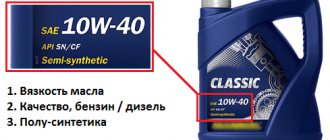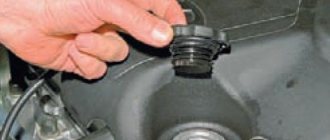The amount of oil in the engine is actually not such a simple question.
An internal combustion engine cannot operate without lubrication.
Moreover, it must be changed periodically. Ideally, the technical documentation contains data about the volume of oil in the engine, its specifications, and the frequency of replacement. While the car is under warranty, this is the problem of service centers (except for your costs for regulations). At the end of the warranty “bondage”, many owners switch to independent maintenance.
In principle, in order to select the correct amount of oil, you do not need to graduate from automotive college. Nevertheless, this question confuses many drivers even at the stage of purchasing consumables. And the seller will be happy to hand you a couple of extra liters with the words: “it’s better to overfill than underfill.”
How much oil should an engine have according to standards?
The question is far from idle. Even if you are a “blonde with a red car,” when coming to an authorized service center, it is advisable to know how much oil to pour into the engine. Scam managers can easily charge you 8 liters instead of the required 4, and you will simply pay for air.
And if you carry out maintenance yourself, you need to have information even more. In this case, it is enough to get it once - the amount of oil in the engine will not change. There are several ways to determine how much oil is required for a specific engine change:
- Routine Maintenance Guide. It has a section: “engine oil and filter.” There you will find reliable information about the type of lubricant, tolerances, oil change intervals and volumes of technical fluids. If such a book is not available, it can be purchased at specialized automotive supply stores.
- Maintenance instructions can be found on the car manufacturers' websites. The documentation may be in English (if you have a foreign car), but it is not difficult to understand: any procedure on the pages of the document is accompanied by pictures.
- Purchase or download a specialized diagnostic and repair program on the Internet. Their cost is quite high, but if you wish, you can find an Internet resource where such software is available in the public domain.
Such programs contain information about how much oil will be in the engine during a complete change (dry, that is, with vacuum pumping), when replacing with a filter and without a filter. - There are also special sites for selecting lubricants. By specifying the make of the car, you will receive the volume with sufficient accuracy.
- And the easiest option for searching for data is specialized forums of car owners. You can get advice from several participants and determine the amount of lubricant with a high degree of confidence.
If none of the above methods are suitable, all that remains is to measure the amount of mining.
Drain all the oil from the crankcase, unscrew the filter, and pour its contents into the same container. You will receive an approximate volume of lubricant (excluding any remaining on the internal walls of the engine).
After which you need to purchase the required amount of consumables as quickly as possible with a reserve of 0.5 - 1.0 liters (you should still have a small reserve for topping up between services). While you are shopping, it is recommended to close the filler and drain necks, and under no circumstances start the engine without lubrication.
The use and importance of oil in a two-stroke engine
- parts in the engine operate with reduced friction and heat up less;
- lubricant in the gaps prevents corrosion of parts during long-term storage and washes out particles acquired during friction;
- the service life of the motor is extended.
The video shows how to make a fuel mixture for two-stroke engines. Refueling mowers, chainsaws, etc.
how much oil to add
for chainsaw, scythe.
The emergence of additional parameters is facilitated by the additives used, which are contained in the oil in an amount of 5-15%. It is the additives that make the oils anti-corrosion, anti-wear and frost-resistant properties.
An incorrect oil composition can kill the engine, forming carbon deposits in the cylinders, leading to coking and rapid engine wear.
It is important to know how much oil to add to the gasoline for a lawn mower. First you should study the annotation and maintain the recommended proportions. The introduction of a composition that takes into account the model and configuration of the motor, climatic conditions and load will extend the life of the lawn mower. How much oil should I add to chainsaw gasoline? How much oil to pour into gasoline? Experienced users recommend that when purchasing a tool, you should immediately purchase the recommended oil in reserve.
What are the dangers of overfilling or underfilling?
There are 2 o and “max” on the oil dipstick
It is important to understand that these values are not related to the degree of engine warm-up (unlike the marks on the coolant expansion tank).
The volume of engine oil in the engine is measured only “cold”. After the trip (when the engine warms up), the car is placed on a flat surface, and you need to wait at least 15-20 minutes. The ideal option is to measure the level in the morning in the garage, before leaving. Then the engine will cool down and all the lubricant will drain to the bottom of the crankcase.
The dipstick is removed from the engine, wiped dry, inserted back, and removed again. The oil trace should be strictly between the marks.
Overfilling leads to the following problems:
- the oil touches the hot cavity of the cylinders, foams and burns out;
- oil scraper rings on the pistons become coked;
- oil seals and gaskets receive additional load (due to pressure) and fail prematurely;
- oil enters the breather fitting, mixes with dust, and creates a tight plug.
Useful tips
- When planning to change engine oil, find out exactly how much it holds in your engine sump. You will always find the exact value in the operating instructions.
- When estimating how much oil to fill when replacing, keep in mind that after draining the waste, some of it remains in the pan. The indicator depends on the shape of the bottom and the location of the drain hole.
- If, when changing the oil, you filled in more than that, you can remove the excess using a large-volume syringe, plastic or rubber tube. You can pump out the excess through the hole for the dipstick. Knowing the difference in volume between filling at the top and bottom marks on the dipstick will help you roughly estimate how much oil needs to be removed from the pan. It is equal to 1 liter. You can, of course, use a drain plug, but this method is fraught with the possibility of getting dirty and is not so convenient for controlling the volume of oil in the engine.
- When the engine is started for the first time after replacement, the low pressure warning light does not go out for some time. To ensure that the engine runs without pressure for as little time as possible after changing the oil, fill the filter before screwing it into place.
- Before screwing the filter on, lubricate the rubber O-ring on it. Screw the filter only by hand without using a filter wrench - it is intended for unscrewing only.
- Monitor the level while operating the machine. A working engine should not consume oil at all: as much as was poured in, so much was drained. The exception is oils with high carbon content, which lose volume even in a working engine.
- To correctly determine the level in the sump, you need to park the car on a level surface and allow time for the engine to cool and for the lubricant to drain into the sump. Pull out the dipstick and wipe it dry, then insert it all the way, carefully remove it and check the level.
Reasons for excessive oil consumption
Among car owners, the question is often asked: how much oil do you need to top up between changes? There is no clear answer to this question. The service instructions for some cars contain information that the so-called. oil consumption “for waste” is acceptable, indicating the quantity.
Practice shows that a serviceable engine consumes an amount that does not exceed the amount of oil left when changing (provided that you knew how much to pour and bought the exact amount).
When draining the waste, about 10% of the amount remains, which is exactly how much oil will remain in the container. And if the motor is worn out, excess consumption occurs for the following reasons:
- oil scraper rings are stuck or require replacement due to wear;
- valve seals (valve seals) have become stiff or worn out;
- the tightness of the cylinder head gasket is broken, lubricant gets into the coolant;
- There are leaks through the pan gasket or oil seals.
How many liters of oil to buy to fill the engine - video
Conclusion: Having received information on how many liters of oil to pour into the engine, you will not fall for the car service deception, and you will not overpay extra money when replacing it yourself. The engine displacement is not directly related to the volume of lubricant.
There is some connection with the number of cylinders (a longer crankshaft, and therefore increased crankcase capacity). You can get the exact data on how much you need to pour into your model from the documentation, or by determining it empirically. The methods are outlined in our material.
How much oil should be poured into the engine? Instructions for selecting and changing oil
As soon as people buy a car, they do not immediately think about the future costs of car care. The first questions of car owners usually concern the lubricant: how much should be poured into the engine, how to check its level, how to replace it, and so on.
General characteristics of engine oil
Car oil can be mineral, synthetic or semi-synthetic. Mineral oil is a natural product obtained by refining petroleum products. Synthetics, as the name suggests, are artificial in nature and are created as a result of chemical synthesis, while semi-synthetics are obtained when mineral and synthetic oil enters the engine.
Which option is the best?
Synthetics retain their beneficial properties the longest. However, many motorists prefer semi-synthetic types and consider it the best. The viscosity parameter is very important for oil. This reduces the friction of engine components against each other, thereby maintaining their properties. Additives are the third most important parameter of oil performance. They perform a cleaning function, remove resin deposits, improve grinding mechanisms during startup, and reduce friction between components.
The best oil in winter
During the cold season, some car owners use the same type as at other times of the year; this is an all-season material. But some, on the advice of experts, switch to special motor oil.
Which is better for cold weather? Depending on the oil change season, it is necessary to take into account not only its quality characteristics, which certainly play a certain role, but also the feasibility of this action. After all, if the car is in a warm garage, it is unlikely that the engine will need any other fluid. For new cars, of course, you cannot skimp on oil. By using the best brands of fluids, car owners will increase the service life of their unit.
How to choose oil for your car
If you want to make the right choice, you must first find your car's owner's manual. After studying it, you will find what properties the oil should meet. However, you can decide for yourself which brand to buy. But it happens that some brands are not suitable for a particular car. Therefore, it is worth paying attention to this attention.
How much oil should be poured into the engine
To answer this question, first read your vehicle's owner's manual. This figure depends on the volume of the car. For example, for an engine with a volume of 1.8 liters to two and a half, the oil should be 3.7 liters. But in practice this is not always the case. The reason is that when the oil is completely changed, it will not flow out completely, but some will remain in the engine.
How to check the oil level
To get the correct number, you need to know how to check engine oil correctly:
How to change the oil yourself
Changing the engine oil yourself takes place in 5 stages:
- Preparing tools and car.
- Drain.
- Replacing the filter.
- Bay
- Checking the level.
The whole process takes 30 - 60 minutes.
What you need before replacing
To change the engine oil yourself, you will need:
- key for unscrewing the underbody protection;
- socket wrench for the pallet plug bolt;
- old belt from the generator for removing the oil filter;
- container with a wide neck for draining;
- fresh motor oil;
- new oil filter;
- sealing washer or new drain bolt;
- clean rags;
- rags;
- funnel;
- gloves.
Before you start, check your car's manual to find out how to remove the protection, where the pan plug is located, how much oil is needed, etc. After theoretical preparation, start practice.
Instructions for changing engine oil
Proper oil change begins with preparing the car. After inactivity, the lubricant becomes viscous and will take a long time to drain. To restore its fluidity, warm up the engine to operating temperature. This may take 10 minutes.
Park the machine on level ground. For ease of work, you can use a lift or overpass. Turn off the engine. Wait 10 minutes for the grease to drain into the pan.
In general, the procedure for changing the oil looks like this: drain the oil and fill in new oil in the amount specified in the service book. However, there are nuances that should not be forgotten, so we will consider the replacement process in detail:
- If your vehicle has an underbody guard, unscrew it first.
- Find the pan plug. Loosen the bolt using a wrench.
- Place a container to drain the old lubricant.
- Carefully unscrew the plug by hand until hot oil flows out.
- It may take about 20 minutes to drain completely, depending on the volume and viscosity of the lubricant.
- Tighten the bolt with the new sealing washer with the required torque to avoid leaks.
- Open the hood. Unscrew the oil filler neck.
- Pull out the oil dipstick.
- Unscrew the oil filter using an old strap around it. Clean the mating surface from old gasket and dirt.
- On the new filter, lubricate the rubber band with engine oil to prevent it from curling up during installation. Screw on the filter.
- Place a funnel into the oil filler neck. Pour in fresh composition in the required volume.
- Check the oil level periodically if the canister does not have a volumetric flask.
- We start the engine so that fresh lubricant passes through the new filter. We jam it.
- We wait until the composition drains into the pan and check the level.
- Screw on the neck cap and put the protection in place.
Similar article Replacing and installing the timing chain of a ZMZ 406 engine with your own hands
The above method refers to a complete manual replacement. Some car services offer another option: change the engine oil using a pneumatic unit. The choice of replacement technology - manual or hardware - depends on the design of the motor, its serviceability, and the experience of the technician. For example, the pans of some internal combustion engines have a complex shape, and the crankcase can only be completely drained through the drain plug. If the filter is installed under the crankcase protection, you still have to crawl under the car. But for the sake of objectivity, we will also outline the positive aspects of express replacement.
Express oil change
Hardware drainage is performed through a dipstick pipe. A device hose is inserted into the hole, through which the lubricant is sucked out of the pan due to vacuum. The process takes no more than 10 minutes.
Some devices are capable of cleaning the engine by displacing the remaining lubricant from the line with compressed air. The procedure can be useful when buying a used car. When you are not sure that the car was properly serviced.
What is needed for an express engine oil change:
- suction apparatus;
- a tube of suitable diameter and length (selected for a specific engine);
- fresh oil.
Sequence of operations for express replacement:
- Take out the dipstick. A suction tube is inserted into the hole so that it reaches the crankcase.
- The other end of the tube is connected to the fitting of the device and the old composition is pumped out.
- After pumping, take out the tube.
- Pour fresh lubricant through the filler neck.
- Check the level.
What are the advantages of express replacement:
- Saves time that is usually spent on dismantling the protection, unscrewing the plug and draining the lubricant.
- There is no need to buy a new sealing washer or bolt for the drain plug every time.
What is engine displacement
The working volume is measured in cubic centimeters or liters. Based on these indicators, cars are divided into the following types:
- The maximum volume is 1.1 liters.
- 1.2-1.7 l.
- 1.8-3.5 l.
- from 3.6 l.
In general, this cannot be taken as an exact division. It applies mainly to gasoline engines. It's different with diesel models.
Displacement is practically the most important indicator. The more fuel that enters the combustion chamber, the greater the car's consumption. This also affects power due to an increase in the amount of energy released.
In addition to high fuel consumption, large cars have another significant disadvantage - high cost. The manufacture of such an engine requires more material. Also, higher demands are placed on such cars.
To determine the working volume of the power plant, it is necessary to take into account the parameters of all cylinders at once. To independently determine the working volume of a cylinder, you need to multiply the working stroke by the area of the circle.
In the example, the total volume is calculated as follows:
- If the car has a four-cylinder engine, and the volume of each is 499 cc. cm, then you need to multiply this figure by 4.
- The result is a volume that is equal to 1996 (can be rounded to 2000). Now you need to divide this figure by 1000 and you get a working volume of 2 liters.
What is the filling volume of engine oil?
The filling volume of engine oil is not the same volume as the working volume. These numbers should not be confused.
All vehicles have their own lubrication system design. In addition to the crankcase, oil is found in the filter, crankshaft, pipeline and other working components. How much lubricant you need to fill can be found in the instruction manual supplied with the car. But this is only relevant if oil is poured into the car for the first time. This figure is only correct when the engine is empty. After draining, a certain amount of grease remains inside (approximately 400 g).
To determine the required amount of oil, you can use specially designed instructions. For example, for domestic cars with an engine capacity of 1.8-2.4 liters, 3.5-4 liters of oil fluid are needed. For imported cars of the same volume, 4-4.3 liters are required.
The oil is poured as follows:
- 3.5-3.8 liters are poured into the neck.
- After 3 minutes the level is checked.
- If the quantity is insufficient, then about 150 g more is added and the level is checked again.
- The procedure is repeated until the tank is completely filled.
The required oil quantity can be seen in the table
So that there is no doubt about the required amount of engine oil, you can turn to specialists at the service station for help.
Oil technical parameters
The main characteristic of oil is viscosity, which depends on many factors: ambient temperature, shelf life, period of use, condition of internal engine components. Each car consumes its own type of oil, which is provided by the manufacturer. It can be changed to synthetic or mineral water, depending on the financial well-being of the owner. True, lowering the grade of fluid may not always be beneficial, but this is up to the individual driver to decide in a particular situation.
Any type can be used for a new engine, since all components and parts fit tightly together. But with the gift, the situation is a little worse. It is not recommended to fill in synthetic oil, as it has high fluidity. This means that it will penetrate into all loose and worn connections, and accordingly there will be a leak. The owner will systematically have to buy liquid for refilling, which is not a cheap pleasure. Therefore, in this situation, mineral motor oil will be just right.
- New engine: SAE class oil 5W30, 10W30, as all-season;
- For a moderately worn engine: in summer SAE 10W40, 15W40, in winter 5W30, 10W30, SAE 5W40;
- Severely worn motor: summer SAE 15W40, 20W40, winter SAE 5W40, SAE 10W40, SAE 5W40.
Refill tanks for some domestic brands:
- Gazelle – 6.0 l.;
- GAZ 3110 “Volga” – 6.0 l.;
- UAZ 469 – 5.9 l.;
- UAZ “Patriot” – 7.1 liters;
- UAZ 452 – 5.9 l.;
- VAZ 2101-2107 – 3.8 l.;
- Lada "Samara" - 3.6 liters;
- Lada "Niva" - 3.8 liters;
- Oka – 2.5 l.











